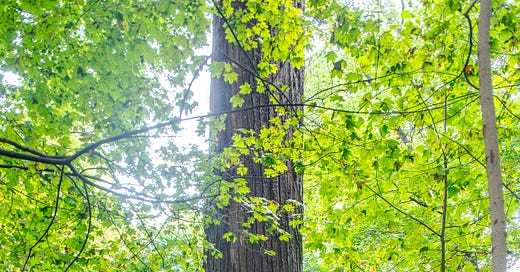Lessons from three years in bonsai
Progress comes in many forms. Some of them are tricky to see.
It’s Fire Escape Bonsai’s third anniversary, and I’m grateful you’re here. I never thought this blog would run so long, but insofar as writing it has become a part of my bonsai experience, the same is true for you reading it. Every comment and kind email puts a smile on my face, and encourages me to keep this project going.
As is tradition, I’m marking the new year with lessons I’ve learned in the previous one. Here are links to past editions:
If you’re in a hurry, scroll down to the end. I have big news—and a shameless plug—to share.
Trees are an anchor. For better and for worse. 2024 is my 10th year in my Jackson Heights apartment. A few aspects of this place make me feel particularly at home: my bed, my kitchen, my tea setup, and now my trees. I come home to a full house of tropical trees these days, and it feels good. It’s also become a serious inconvenience if I’m away for more than a couple nights. At this point my collection is too large to sweet-talk my neighbor friend into watering it. After a long nesting period, I’m feeling the itch to get out and travel again. I’ll have to hire a plant sitter who can tell when each of my 20something trees needs a drink.
It’s good to know when to stop. Speaking of 20something trees, my goal for 2024 is to avoid buying new ones. I have room outdoors for a really good deal, but my indoor grow rooms are at capacity, and so is my attention. Any new trees will have to come from propagations. I can justify that addition; it’s more self sufficient.
There’s only so much I can do alone. I’ve reached the point in my bonsai education where I need to talk with other growers to advance. I’m getting more vocal on forums, but I’d rather meet up with bonsai people in person. Learning isn’t just about accumulating knowledge; it’s about developing a social understanding.
The growth will come. Even if a tree seems stuck for months, like my sacred figs. Wait it out. The growth will come.
It’s okay to move on when a tree isn’t working. I recently composted a healthy water jasmine. It was taking up too much room and wasn’t going anywhere. The roots alone would have taken years to fix and the trunk wasn’t very interesting. Meanwhile, a cutting I made from that tree is thriving, and a cutting I made from that cutting is doing well, too. In this case, it was time for the parent to make room for its offspring.
Take risks on practice material. I never expected my dwarf Alberta spruce to live long. It was a cheap practice tree from my early days that served its purpose; now I’m onward to better material. So I took a risk and aggressively restyled it. The tree didn’t make it. One more lesson learned.
It’s okay to take pride in your work. I’ve slowly realized that in my vigorous pursuit of humility—smart mouth to the contrary, a quality I aim to embody—I may overshoot the mark past pride and satisfaction. I reflexively deflect praise and redirect the conversation to my trees’ faults and limitations. My first draft of this subheading even read, “It’s okay to take pride in your so-so work.” That’s not good!
You grow with your trees. That said, I’m undeniably gaining skills that are paying off on my bonsai; see this dynamite little umbrella tree. As my trees develop, they face new challenges that require greater skill. Fortunately, I seem to be keeping pace. We’re meeting the challenges together.
Enjoy your trees as they are. Somewhere on the internet I saw the phrase “don’t borrow misery from the future,” and I feel like it rebooted my brain. Many of my bonsai are in an awkward phase, waiting for more growth before I can take the next steps. I spend a lot of pointless time worrying how they’ll react to those eventual next steps—time I could devote to appreciating them as they are now, before they’re irreversibly changed.
You can’t do it all at once. I’m impatient to try out air layers and grafting techniques, but none of my material is ready for either. In more temperate moods, I remind myself that bonsai isn’t going anywhere. Leave something to the future, and to strive for.
Nature follows its own schedule. I wish my new calamansi tree would stop growing flowers. I’ve had it for months now and it’s hardly put out a new leaf. All its energy goes into flowers, which slows down my plans to thicken the trunk. Faced with a tree as stubborn as I am, all I can do is wait it out. The growth will come.
Leafhopper, a newsletter for tea drinkers and allies
Three years of writing this blog have encouraged me to branch out to another passion of mine: tea. This week, I launched Leafhopper, a newsletter about brewing and buying better tea, and how to get more out of your cup.
Unlike bonsai, I actually know a thing or two about tea. I’ve covered the topic and industry for more than a decade as a journalist, meeting with growers, traders, and sellers that rarely speak to the public. Leafhopper will give a home to stories from those travels that are too niche or weird for mainstream publishers, and hard to find elsewhere on the internet. Believe me, I’ve looked, and I wound up having to write some of it myself.
I think my work on tea has value, so Leafhopper will include a paid membership. Each week, I’ll explore a special facet of the tea world: the craft, culture, business, history, philosophy, technology, and chemistry that permeate every cup. A free public digest will feature a recommended tea with notes about where it comes from and tips to brew a good pot. A paywalled deep dive section will host an essay, drinking guide, conversation, or travel diary exclusively for paid subscribers. Consider these paywalled stories a candid course in tea appreciation, written to help you become a smarter drinker.
To be candid with you now, it’s hard out here for a journalist, which feels ridiculous to say because it’s hard out here for all of us. But the covid pandemic has hastened the media industry’s rapid erosion. Even institutions once thought unassailable are giving writers a raw deal. Newspaper freelance rates haven’t changed in decades; since I filed my first article (it’s on tea!) for the New York Times in 2017, the dollar has lost 19% of its buying power. Other sainted publications are resorting to SEO chum and advertorial “commerce content” at the expense of the quality storytelling that made their names. Many have cut their freelance budgets to zero.
I believe that if working writers are to survive, we need to own the means of production. That means control over our work, its distribution, and its revenue directly from readers. I hope I’ve earned your trust over the years. If you’ve found value in my work on Fire Escape Bonsai or elsewhere, and want to learn more about the world’s most popular drink, consider a paid membership or gift subscription to Leafhopper.
What does this mean for Fire Escape Bonsai? I’m not sure yet. I don’t want to go anywhere, but in truth I’ve found that the deeper I get into bonsai, the less I feel I have to say about it. If I can indulge your patience, I’d like to see how the next few weeks go and figure out a feasible publishing cadence. How do you feel about a biweekly schedule? Monthly? Spontaneous irregular updates? I’d love to know. Thank you, as always, for reading.





I enjoy your articles. As far as frequency I suggest monthly or simply when there is sufficient news to write about.
https://www.instagram.com/reel/C20W73EqQ2G/?igsh=MW93aGxjYzlhdWt2YQ==